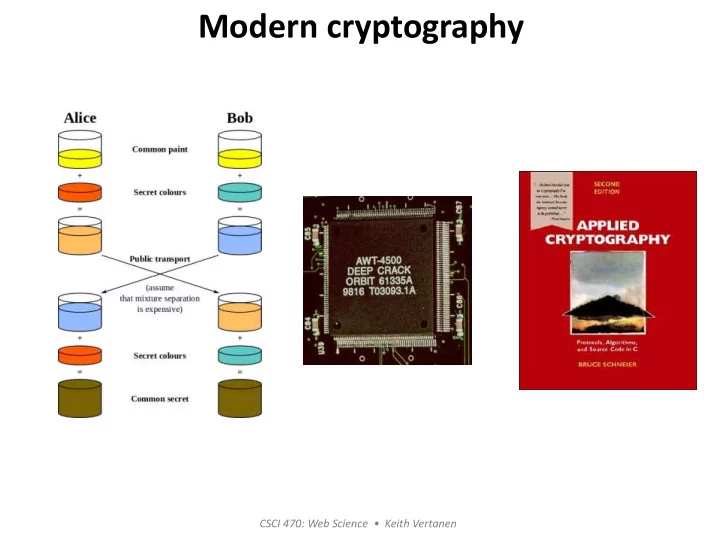

Modern cryptography CSCI 470: Web Science • Keith Vertanen
Overview • Modern cryptography – Symmetric cryptography • DES • 3DES • AES – Asymmetric cryptography • Diffie-Hellman key exchange 2
Modern cryptography • Moving into computer age – Not limited to physical engineering constraints • 100's of rotors instead of 3, changing in complex ways • Much faster • Scrambling at the bit level • Symmetric encryption (what we've seen thus far) – Encrypting message M with key K: E k (M) = C – Decrypting ciphertext C with key K: D K (C) = M – D K (E K (M))=M – Stream cipher: operates one bit/byte at-a-time – Block cipher: operates on a group of bits/bytes 3
Bit encryption / decryption example Message : HELLO Sender Binary : 1001000 1000101 1001100 1001100 1001111 KEY = DAVID : 1000100 1000001 1010110 1001001 1000100 Encrypted (XOR) : 0001100 0000100 0011010 0000101 0001011 Receiver Encrypted : 0001100 0000100 0011010 0000101 0001011 KEY = DAVID : 1000100 1000001 1010110 1001001 1000100 Decrypted (XOR) : 1001000 1000101 1001100 1001100 1001111 4
DES • Data Encryption Standard (DES) – NIST wanted a government standard – Based on IBM's Lucifer cipher • 16 round Feistel network • Security provided by a key • With "cooperation" from NSA: – Improved S-boxes – Reduced key length to 56 bits – 1976 approved as a standard – Same hardware/software can encrypt/decrypt "DES did more to galvanize the field of cryptanalysis than anything else. Now there was an algorithm to study: one that the NSA said was secure" -Bruce Schneier 5
The Feistel function (F-function) Key schedule E-box, expansion permutation, 32 -> 48 bits Overall structure 6
S-box #5, 6 bits -> 4 bits, e.g. 011011 -> 1001 (9) P-box, straight permutation, 32 bits -> 32 bits The Feistel function (F-function) 7
Breaking DES • Key size, 72 quadrillion – 2 56 = 72,057,594,037,927,936 • DES Challenges (brute force) – Sponsored by RSA Security • Challenge I: 96 days, Internet users • Challenge II: 41 days, distributed.net • Challenge II-2: 56 hours, EFF deep crack – $250,000 to develop, $10,000 prize – 90 billion keys/second • Challenge III: 22 hours, EFF+distributed.net – 2008, FPGA, 1 day 8
Stronger symmetric schemes • Triple DES (3DES) – Ciphertext: E K3 (D K2 (E K1 (plaintext))) – Plaintext: D K1 (E K2 (D K3 (ciphertext))) – Keying option 1: K1 ≠ K2 ≠ K3 • 168 bits = 56 bits x 3 – Advantages: • Uses DES, most analyzed encryption algorithm • No known effective attack (besides brute force) – Disadvantages: • Slow in software, DES designed for 1970's hardware • Small block size of 64-bits 9
AES • Advanced Encryption Standard (AES) – 2001 new NIST standard, Rijndael – Symmetric block cipher – Key lengths of 128, 192, and 256 bits – Approved by NSA for top secret information http://www.moserware.com/2009/09/stick-figure-guide-to-advanced.html 10
Attack types • Ciphertext only – Ciphertext of message(s), plaintext unknown • Known plaintext – Ciphertext plus corresponding plaintext • Chosen plaintext – Ciphertext plus plaintext of your own choosing – Adaptive chosen plaintext • Modify plaintext based on previous decryptions • Rubber hose • ... 11
Key exchange • Thus far: symmetric encryption – Alice and Bob need to have shared secret – But how do you distribute? – Doesn't scale Bob Alice 12
Diffie-Hellman • Diffie-Hellman (DH) key exchange – 1976, Whitfield Diffie & Martin Hellman – Alice and Bob agree on a private secret: • On a public channel http://www.youtube.com/watch?v=3QnD2c4Xovk • Where Eve hears all the traffic • Only Alice and Bob end up knowing the secret – Relies on one-way function • Function must be easy to do, but difficult to undo Whitfield Diffie Martin Hellman 13
Alice Bob Alice and Bob agree publicly on values for Y and P for the one-way function: Y x (mod P) , e.g. Y=7, P=11 Alice chooses secret Bob chooses secret number: number: A = 3 B = 6 α = 7 A (mod 11) β = 7 B (mod 11) = 7 3 (mod 11) = 7 6 (mod 11) = 343 (mod 11) = 117649 (mod 11) = 2 = 4 Sends α = 2 to Bob Sends β = 4 to Alice Using Bob's result: Using Alice's result β A (mod 11) α B (mod 11) 4 3 (mod 11) = 9 2 6 (mod 11) = 9 7 B*A (mod 11) 7 A*B (mod 11) 14
Public key cryptography • Diffie-Helman key exchange – Both parties had to be around to negotiate secret • Symmetric encryption – Encrypting message M with key K: E k (M) = C – Decrypting ciphertext C with key K: D K (C) = M • Asymmetric encryption – 1975, Diffie conceives of idea – Users have a private key and a public key • Alice encrypts plaintext with Bob's public key • Only Bob can (tractably) decrypt using his private key – Special one-way function • Hard to reverse unless you know something special 15
Summary • Modern cryptography – Computer-based symmetric ciphers • DES, 3DES, AES – Rise of asymmetric cryptography • Diffie-Hellman 16
Recommend
More recommend